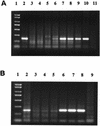Production and characterization of monoclonal antibodies specific for a conserved epitope within hepatitis C virus hypervariable region 1
- PMID: 11711631
- PMCID: PMC116137
- DOI: 10.1128/JVI.75.24.12412-12420.2001
Production and characterization of monoclonal antibodies specific for a conserved epitope within hepatitis C virus hypervariable region 1
Abstract
Frequent mutations in hypervariable region 1 (HVR1) of the main envelope protein of hepatitis C virus (HCV) is a major mechanism of persistence by escaping the host immune recognition. HVR1 contains an epitope eliciting neutralizing antibodies. This study was aimed to prepare broadly cross-reacting, high-affinity, monoclonal antibodies (MAb) to the HVR1 C terminus of HCV with potential therapeutic neutralizing capacity. A conserved amino residue group of glycine (G) at position 23 and glutamic acid (Q) at position 26 in HVR1 was confirmed as a key epitope against which two MAbs were selected and characterized. MAbs 2P24 and 15H4 were immunoglobulin G1 kappa chain [IgG1(kappa)], cross-reacted with 32 and 30 of 39 random C-terminal HVR1 peptides, respectively, and did not react with other HCV peptides. The V(H) of 2P24 and 15H4 heavy chains originated from Igh germ line v gene family 1 and 8, respectively. In contrast, the V(L) kappa sequences were highly homologous. The affinity (K(d)) of 2P24 and 15H4 (10(-9) or 10(-8) M with two immunizing peptides and 10(-8) M with two nonimmunizing HVR1 peptides) paralleled the reactivity obtained with peptide enzyme immunoassay. MAbs 2P24 and 15H4 captured 25 of 31 (81%) HCV in unselected patients' plasmas. These antibodies also blocked HCV binding to Molt-4 cells in a dose-dependent fashion. The data presented suggest that broadly cross-reactive MAbs to a conserved epitope within HCV HVR1 can be produced. Clinical application for passive immunization in HCV-related chronic liver disease and after liver transplantation is considered.
Figures





Similar articles
-
Chimeric monoclonal antibodies to hypervariable region 1 of hepatitis C virus.J Gen Virol. 2005 Jun;86(Pt 6):1709-1716. doi: 10.1099/vir.0.80912-0. J Gen Virol. 2005. PMID: 15914849
-
Role of the E2 Hypervariable Region (HVR1) in the Immunogenicity of a Recombinant Hepatitis C Virus Vaccine.J Virol. 2018 May 14;92(11):e02141-17. doi: 10.1128/JVI.02141-17. Print 2018 Jun 1. J Virol. 2018. PMID: 29540595 Free PMC article.
-
Broadly cross-reactive, high-affinity antibody to hypervariable region 1 of the hepatitis C virus in rabbits.Virology. 1999 Jun 5;258(2):396-405. doi: 10.1006/viro.1999.9730. Virology. 1999. PMID: 10366577
-
Variability or conservation of hepatitis C virus hypervariable region 1? Implications for immune responses.J Biosci. 2003 Apr;28(3):305-10. doi: 10.1007/BF02970149. J Biosci. 2003. PMID: 12734408 Review.
-
Hypervariable region 1 of hepatitis C virus: immunological decoy or biologically relevant domain?Antiviral Res. 2001 Nov;52(2):153-9. doi: 10.1016/s0166-3542(01)00180-2. Antiviral Res. 2001. PMID: 11672825 Review.
Cited by
-
Cross-reactivity of hypervariable region 1 chimera of hepatitis C virus.World J Gastroenterol. 2003 Jun;9(6):1256-60. doi: 10.3748/wjg.v9.i6.1256. World J Gastroenterol. 2003. PMID: 12800235 Free PMC article.
-
Characterization of antibody-mediated neutralization directed against the hypervariable region 1 of hepatitis C virus E2 glycoprotein.J Gen Virol. 2011 Mar;92(Pt 3):494-506. doi: 10.1099/vir.0.028092-0. Epub 2010 Nov 17. J Gen Virol. 2011. PMID: 21084495 Free PMC article.
-
Separation of Hepatitis C genotype 4a into IgG-depleted and IgG-enriched fractions reveals a unique quasispecies profile.Virol J. 2008 Sep 23;5:103. doi: 10.1186/1743-422X-5-103. Virol J. 2008. PMID: 18811965 Free PMC article.
-
Impact of host responses on control of hepatitis C virus infection in Chinese blood donors.Biochem Biophys Res Commun. 2011 Nov 25;415(3):503-8. doi: 10.1016/j.bbrc.2011.10.102. Epub 2011 Oct 29. Biochem Biophys Res Commun. 2011. PMID: 22062549 Free PMC article.
-
Significance of monoclonal antibodies against the conserved epitopes within non-structural protein 3 helicase of hepatitis C virus.PLoS One. 2013 Jul 24;8(7):e70214. doi: 10.1371/journal.pone.0070214. Print 2013. PLoS One. 2013. PMID: 23894620 Free PMC article.
References
-
- Alberti A, Chemello L, Benvegnu L. Natural history of hepatitis C. J Hepatol. 1999;31(Suppl. 1):17–24. - PubMed
-
- Allain J P, Zhai W, Shang D, Timmers E, Alexander G J M. Hypervariable region diversity of hepatitis C virus and humoral response: comparison between patients with or without cirrhosis. J Med Virol. 1999;59:25–31. - PubMed
-
- Aswad S, Mendez R, Weingart R G, Mendez R. Expanding organ availability by using hepatitis C antibody-positive donors. Transplant Proc. 1993;25:2270–2271. - PubMed
Publication types
MeSH terms
Substances
LinkOut - more resources
Full Text Sources
Other Literature Sources
Molecular Biology Databases

